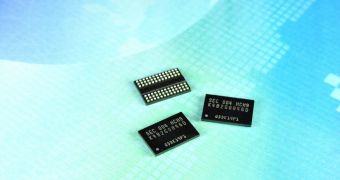While Intel and Micron are proudly enjoying the glory of being the first to develop 25nm NAND flash, Samsung is enjoying an accomplishment of its own. The Company released 30nm high-density NAND earlier this month and, now, even the 30nm DDR3 technology has been completed. Samsung proudly announced that its first 30nm-class DRAM had successfully passed customer evaluation.
When applied to DDR3 mass production, the 30nm manufacturing process raises productivity by 60 percent, compared with the 40nm-class DDR3, and by 200 percent over the 50nm- to 60nm-class technologies. DDR3 is steadily becoming dominant and the company's aggressive advancement in this area will speed the process up, with more servers, notebooks and desktops likely to choose 1.5V and 1.35V DDR3.
The adoption of the new DDR3 will be encouraged not just by the cost-efficiency, but also thanks to the reduced power consumption. The “most advanced low-power DDR3 available today” title is enabled by the fact that the 2Gb Green DRAM has a power consumption of up to 30 percent lower than that of the 50nm-class. In fact, a 4GB 30nm module will only use up three watts per hour when employed in a new-generation notebook PC, which corresponds to 3% of the total power consumption of such a laptop. Of course, the range of products where the new DDR3 will be used extends to more than just notebooks, including the aforementioned servers and desktops, as well as future versions of netbooks and mobile devices.
“Our accelerated development of next generation 30nm-class DRAM should keep us in the most competitive position in the memory market,” Soo-In Cho, president, Memory Division, Samsung Electronics, said. “Our 30nm-class process technology will provide the most advanced low-power DDR3 available today and therein the most efficient DRAM solutions anywhere for the introduction of consumer electronics devices and server systems.”
Mass production of the new 30nm DRAM will commence sometime during the second half of the ongoing year. Information on Samsung's Green DDR3 may be found here.

 14 DAY TRIAL //
14 DAY TRIAL //